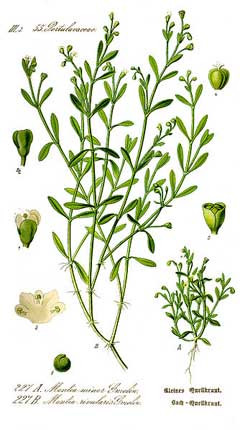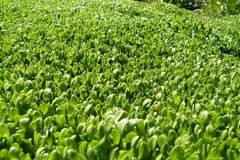 |
|
http://commons.wikimedia.org/wiki/File:Illustration_Polycarpon_polycarpoides0_clean.jpg |
 |
| http://commons.wikimedia.org/wiki/User:Abalg |
Translate this page:
Summary
Physical Characteristics

 Montia fontana is a ANNUAL/PERENNIAL growing to 0.5 m (1ft 8in).
Montia fontana is a ANNUAL/PERENNIAL growing to 0.5 m (1ft 8in).
It is not frost tender. It is in flower from May to October, and the seeds ripen from June to October. The species is hermaphrodite (has both male and female organs) and is pollinated by Insects, Cleistogomy (self-pollinating without flowers ever opening). The plant is self-fertile.
Suitable for: light (sandy), medium (loamy) and heavy (clay) soils and can grow in nutritionally poor soil. Suitable pH: mildly acid, neutral and basic (mildly alkaline) soils. It can grow in semi-shade (light woodland) or no shade. It prefers moist or wet soil and can grow in water.
UK Hardiness Map
US Hardiness Map
Synonyms
Plant Habitats
Woodland Garden Dappled Shade; Shady Edge; Pond; Bog Garden;
Edible Uses
Edible Parts: Leaves
Edible Uses:
Leaves - raw[46, 61, 177, 183]. Fairly bland, they are quite nice in a salad. The leaves can turn bitter in summer, especially if the plant is growing in a hot dry position.
References More on Edible Uses
Medicinal Uses
Plants For A Future can not take any responsibility for any adverse effects from the use of plants. Always seek advice from a professional before using a plant medicinally.
None known
References More on Medicinal Uses
The Bookshop: Edible Plant Books
Our Latest books on Perennial Plants For Food Forests and Permaculture Gardens in paperback or digital formats.

Edible Tropical Plants
Food Forest Plants for Hotter Conditions: 250+ Plants For Tropical Food Forests & Permaculture Gardens.
More

Edible Temperate Plants
Plants for Your Food Forest: 500 Plants for Temperate Food Forests & Permaculture Gardens.
More

More Books
PFAF have eight books available in paperback and digital formats. Browse the shop for more information.
Shop Now
Other Uses
References More on Other Uses
Cultivation details
Prefers a moist peaty soil. A polymorphic species[17].
References Carbon Farming Information and Carbon Sequestration Information
Temperature Converter
Type a value in the Celsius field to convert the value to Fahrenheit:
Fahrenheit:
The PFAF Bookshop
Plants For A Future have a number of books available in paperback and digital form. Book titles include Edible Plants, Edible Perennials, Edible Trees,Edible Shrubs, Woodland Gardening, and Temperate Food Forest Plants. Our new book is Food Forest Plants For Hotter Conditions (Tropical and Sub-Tropical).
Shop Now
Plant Propagation
Seed - sow spring or autumn in situ. The seed usually germinates rapidly.
Other Names
If available other names are mentioned here
Native Range
TEMPERATE ASIA: Turkey, Russian Federation (Buryatia (south), Irkutsk (south), Yakutia-Sakha (north)) TROPICAL ASIA: Indonesia (Papua), Papua New Guinea NORTHERN AMERICA: Canada (Northwest Territories, Yukon, Québec, Nova Scotia, Prince Edward Island, New Brunswick, Newfoundland and Labrador, Manitoba, British Columbia), Greenland, St. Pierre and Miquelon, United States (Alaska, Maine, Massachusetts, New Hampshire, New York, Vermont, Idaho, Montana, Oregon, Washington, Wyoming, California, Nevada, Utah) SOUTHERN AMERICA: Bolivia, Colombia, Ecuador, Peru AUSTRALASIA: Australia (Tasmania, New South Wales (southeast), South Australia (south), Victoria), New Zealand EUROPE: Denmark, Finland, United Kingdom, Ireland, Iceland, Norway, Sweden, Austria, Belgium, Switzerland, Czech Republic, Germany, Hungary, Netherlands, Poland, Estonia, Lithuania, Latvia, Russian Federation (Karelia, Komi, Arkhangelsk, Neneckij avtonomnyj okrug, Kaliningrad, Leningradskaja oblast, Moscow, Murmansk, Novgorod, Tver, Vologda, Yaroslavl), Bulgaria, Greece (incl. Crete), Croatia, Italy (incl. Sardinia, Sicily), North Macedonia, Romania, Serbia, Slovenia, Spain, France (incl. Corsica), Portugal AFRICA: Morocco, Ethiopia, Kenya, Tanzania, Uganda, Democratic Republic of the Congo (east)
Weed Potential
Right plant wrong place. We are currently updating this section.
Please note that a plant may be invasive in one area but may not in your area so it's worth checking.
Conservation Status
IUCN Red List of Threatened Plants Status :

Growth: S = slow M = medium F = fast. Soil: L = light (sandy) M = medium H = heavy (clay). pH: A = acid N = neutral B = basic (alkaline). Shade: F = full shade S = semi-shade N = no shade. Moisture: D = dry M = Moist We = wet Wa = water.
Now available:
Food Forest Plants for Mediterranean Conditions
350+ Perennial Plants For Mediterranean and Drier Food Forests and Permaculture Gardens.
[Paperback and eBook]
This is the third in Plants For A Future's series of plant guides for food forests tailored to
specific climate zones. Following volumes on temperate and tropical ecosystems, this book focuses
on species suited to Mediterranean conditions—regions with hot, dry summers and cool, wet winters,
often facing the added challenge of climate change.
Read More
Expert comment
Author
L.
Botanical References
17270
Links / References
For a list of references used on this page please go here
Readers comment
| Add a comment |
|
If you have important information about this plant that may help other users please add a comment or link below. Only comments or links that are felt to be directly relevant to a plant will be included. If you think a comment/link or information contained on this page is inaccurate or misleading we would welcome your feedback at [email protected]. If you have questions about a plant please use the Forum on this website as we do not have the resources to answer questions ourselves.
* Please note: the comments by website users are not necessarily those held by PFAF and may give misleading or inaccurate information.
To leave a comment please Register or login here All comments need to be approved so will not appear immediately.
|
|